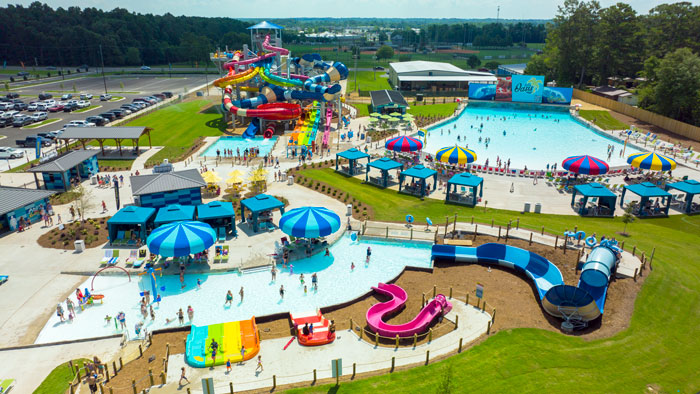Many community swimming pools of old are continuing their evolution into aquatic parks, incorporating a range of pool types and amenities including lazy rivers, adventure and skill-based attractions, climbing walls and ninja courses, expanded splash play with interactive features and an assortment of waterslides. And pools used for traditional lap swimming and competition are also incorporated into designs, as are enhanced support spaces, all aimed at attracting a wide range of ages and demographics.
“In recent years, many owners have been saying goodbye to traditional pools and saying hello to pools that honor every type of lifestyle,” said Jen Gerber, vice president of strategic partnerships and operations for Water Technology Inc. “To achieve this, aquatic centers are being designed with multi-programmable water that provides flexible multi-use spaces for people of all ages and abilities.”
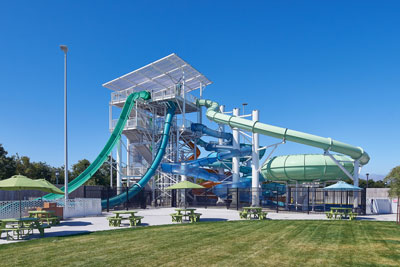
According to Justin Caron, principal and CEO at Aquatic Design Group, municipalities of all sizes are exploring creative avenues to generate additional revenues at their facilities. “Adding waterpark-type attractions to an aquatic center not only helps offset operating costs but can act as a signature element or ‘billboard’; you can see the slide or attraction from the road, which will draw in new guests.”
To draw visitors from other communities, it’s essential to provide fresh, new, multigenerational amenities, according to Frank Parisi, COO and managing principal with Williams Architects. This might include balancing “something a little more calm and relaxing” with attractions like speed slides, racing slides, wave runners, climbing walls and obstacle courses, “allowing for interaction between generations. The challenge is dedicating water to a particular amenity. The opportunity in the design is to maximize the flexibility of that water, not only from an entertainment perspective but also incorporating health and wellness, such as resistive walking in current channels or lazy rivers.”
Sophia Young, communications manager for Waters Edge Aquatic Design, agreed that facilities often strive to be unique, potentially attracting out-of-town visitors. “To do that, communities build a pool as a regional attraction and destination spot. Trends we see when trying to design a unique facility are the variations in the slides, lazy rivers, zero-depth entries and kids’ spaces. It’s common for newer pools to possess these, however the size and thrill of each can vary greatly, often dictated by budget.”
Another determining factor is “resource requirements,” according to Lauren Ozburn, who’s involved with project management and operations at Waters Edge. “It’s important to consider permitting and code requirements in your area, as the various jurisdictions will have guidance on what types of amenities are permitted.”
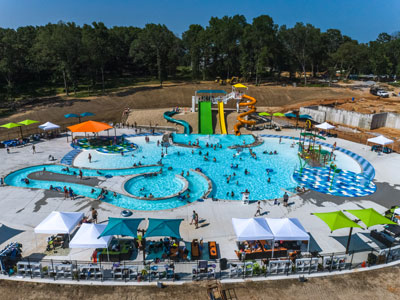
“Zero-depth entry, waterslides and lazy rivers are almost synonymous with today’s aquatic centers,” Gerber added, “though they aren’t necessarily new trends. These tried-and-true amenities work for a reason; people want to be entertained. Commercial waterparks are a big influence in the municipal family aquatic center. FAC’s are making rides more exciting to keep up with users’ entertainment needs. We are starting to see adventure amenities like wave pools, surf pools, launching slides and stand-up slides, inflatable water play, adventure courses, climbing walls, etc., in municipal environments. Balancing innovation and budget/schedule should be a top priority for the aquatic design firm.”
Skill-based attractions continue to be popular with all ages, and families will sometimes choose their vacation destinations based on aquatic park attractions available, according to David Keim, director, public market business development at Aquatic Development Group. “Skill-based attractions promote repeat visitation as guests work to improve their skills,” he added.
Keim said the surfing or boogie boarding attractions are among the most popular skill-based amenities, including sheet wave surf attractions and deep-water stationary waves offering a true surfing experience. “Additionally, aquatic challenge courses (ninja-style and inflatable) are becoming quite popular, and climbing walls are available at more facilities. Of course, the tried-and-true features, such as a crossing activity, and even water basketball and volleyball, appeal to park guests.”
“Skill-based, extreme and adventure attractions are a primary factor in a facility being able to expand their geographic
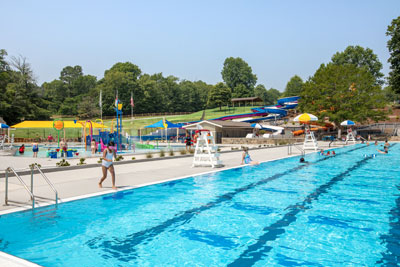
influence as a regional attraction and compete with other industry providers,” said Darren Bevard, principal at Counsilman-Hunsaker, which offers design, planning and operations services to the aquatics industry. He added that these types of attractions can also help attract the teen and pre-teen demographic. “We often analyze this through feasibility analysis in the planning phase of a development project. Investment in these types of features will typically have a significant impact on operational pro forma.”
To achieve the goal of being truly unique, Young said “We even see communities with multiple pools trying to make each pool distinguishingly different. To achieve this, a different purpose and theming of each facility gets considered. One pool might be more competitive swimming focused, while another might be designed for young families. Sometimes it’s a hybrid of both.”
As community pools feature bigger attractions and added activities, many still maintain traditional recreation and competition pools, offering lap lanes, swim instruction and exercise programs. “If you look closely at some pool designs with lap lanes, you’ll begin to recognize the action packed into the one space,” said Young. For example, a lap lane might transition into a deep diving well, or the area might have a climbing wall or basketball hoop, or serve as a plunge area for some slides. “From an operations standpoint, it takes planning to coordinate when lap lanes are open and when other features are available, but utilizing the lap lane area for other features allows for a flexible design.”
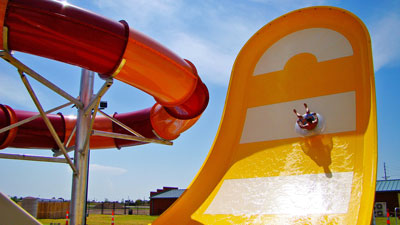
And what about the good old lazy river; are these still popular amenities as communities expand their parks? “Market research identifies outdoor, recreation-only program offerings as the highest cost-recovery model for an aquatic facility,” said Caron, who added that these attractions can help differentiate facilities from other competing facilities in the region. “Additionally, river channels and vortexes are being included in at least a third of new projects with multipurpose or recreation pools as they serve as a fun attraction for all ages but can also be integrated into therapy and fitness classes.”
“Lazy rivers continue to be a popular choice, but these aren’t the plain vanilla rivers of old,” said Keim. “Wider and shallower rivers offer increased capacity, while theming makes them special. In addition to lazy rivers, fast rivers, wave rivers and action rivers continue to gain traction.”
Added Parisi, “Incorporating interactive features along the way such as deck sprays, bubblers and waterfalls will enhance the experience.”
Many of these aquatic parks are also offering enhanced locker rooms and social spaces, expanded food and beverage options and upgraded materials and finish selections, which Bevard said is the case in both the public and private sectors. “There’s been a growing trend to cater to the hospitality-type experience through provision of enhancements that make the facility more comfortable, inviting, enjoyable, unique and/or trendy, and increase the patron length of stay.”
Cabanas and bars can be significant revenue generators, according to Keim. “A cabana provides guests with their own semi-private oasis inside the park. Convenient cabana service provides additional revenue opportunities. Creative and slightly upscale food and beverage offerings are always appreciated. Lockers continue to become easier to access while adding to the revenue stream. Time and time again, guest surveys include clean restrooms and changing areas at the top of the list. Park layouts that incorporate uncrowded, convenient features, facilities, lockers, etc., add to guest enjoyment.”
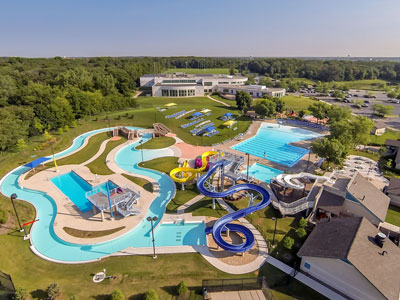
Parisi explained that in public surveys, shade is a highly-requested amenity at aquatic facilities, which can be provided both in and out of the water. “Additionally, nature-based areas like family lawns with shade, slightly removed from pool amenities, and concentration of concrete decks are also sought after.”
As facilities add on various water and non-water features, space utilization becomes even more critical. “Programming and designing a modern aquatic facility isn’t the same as it was just a few years ago,” said Caron. “More and more programs are being offered at these facilities, which requires an understanding of what works best and where it should be placed.” He said that pedestrian circulation, ease of use and amenity locations are all important considerations. “Creating flexible spaces that can serve multiple purposes is a key to any modern aquatic or recreation center.”
“Location and spatial adjacency of features, zoning of the facility with respect to age groups/user groups, events, traffic patterns and capacity analysis are all critical design considerations,” said Bevard. And Parisi pointed out that due to the recent operational demands on lifeguards since COVID, planning facilities to maintain operational efficiency has become a priority. “Creative planning to allow compartmentalizing bodies of water may reduce the operational impact from a life safety perspective.”
“The design of a facility is influenced by many factors; restroom accommodations, traffic flow or where and how chemicals and supplies are delivered are considered to optimize functionality,” said Young, who explained that day-to-day operations and guest experience are critical considerations when planning a facility. “That begins early in the process, and is considered as soon as they enter the parking lot all the way through the facility.”
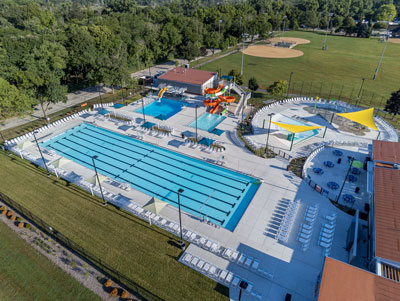
In Sioux Center, Iowa, the city decided to expand its existing indoor and outdoor aquatic facilities into a larger aquatic park to serve a more diverse user base. To offer a place for young people to gather, they created the Teen Corner, placed next to age-appropriate features. “The Teen Corner is a fully-shaded circular space on the pool deck with various seating, speakers, outlets for charging devices and Wi-Fi,” said Young. “Multiple spaces in Sioux Center were created to appeal to different age demographics.”
“Creating different pockets or pods for guests to sit or hang out is a way to satisfy the needs and comfortability of each demographic,” said Ozburn. “Programming the spaces to meet the various needs of the user groups is a key way a facility can serve and appeal to the full spectrum of age groups. This may mean offering a variety of programs at different times throughout the day or on staggering days.”
In Bartlett, Ill., a community survey found that residents strongly supported the idea of improving their aging aquatic facility. And now the significantly expanded Bartlett Aquatic Center (BAC) features an eight-lane lap pool with zero-depth entry, lazy river, plunge pool with drop slide, aquatic zip line attraction, tube and body slides, spray playground, sand-play area, children’s waterslide and concessions area.
Natalie Reed, aquatics manager at the Bartlett Park District, shared some visitor favorites: “The tube slide, drop slide and zip line are our most popular attractions. Siblings and friends love using one of our double tubes to go down the big blue tube slide together. Everyone wants to try the zip line, both children and adults!”
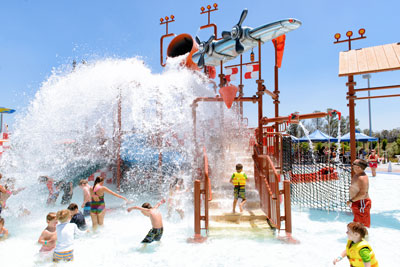
The lazy river is popular for kids who can swim and adults who want to relax, according to Reed, who said they offer single and double tubes for floating. A lazy river walking class is offered a couple times a week where participants can follow a lead instructor or walk at their own pace. “A lot of ladies on Tuesday nights will just walk and talk with their friends. The program is very popular with our community.
“The lap and leisure pool is primarily used for recreational purposes, although we do have a lap lane dedicated to adults only,” continued Reed. “A lot of mothers and their small children love utilizing our zero-depth entrance and the spraying mushroom feature we have in the shallow end.”
A community swim team utilizes the lap pool for practices, and meets are hosted throughout the summer. Bleacher and deck seating is provided for spectators, but many parents like to set up on the grassy hill, which features shade structures.
Special events—including the Turbo Turtle Race fundraiser—are held at BAC, according to Reed. And last summer, Disney characters came to “hang out and take pictures with kids visiting the pool; it was very popular with our younger age groups. We also had yard games, a scavenger hunt and prizes to win.”
Private rentals are available, for either the full facility or just certain sections or attractions, and Reed said the concessions area is a hit. Additionally, there are three mechanical rooms: “one for the lazy river side of the facility, one for the lap pool and white slide and one for the spray playground.”
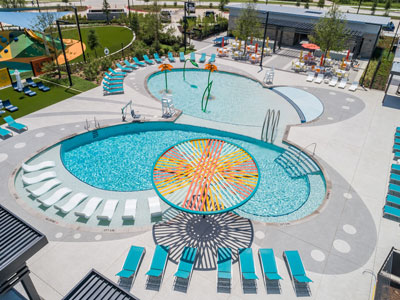
In fact, splash and spray areas are being added to many aquatic parks, according to Chris Thomas, director of marketing at a San Marcos, Texas-based designer and manufacturer of interactive water features and aquatic play equipment. He said in recent years, his industry has made creating inclusive areas a priority. “Many recreation departments and community centers are looking to create aquatic play spaces that welcome users with a wide range of developmental, cognitive and physical abilities, as well as different age groups, including older generations acting as caregivers.”
Thomas explained that splash play areas are “designed with different zones to attract a wide range of patrons using a variety of water features, water flows, spacing, sizes and colors to make the facility more accessible to users.” He said designers can create a sequence of features, starting with sensory exploration and graduating to features with increased intensity.
Gerber added that as many communities are building larger, regional aquatic facilities, they are also adding independent neighborhood splash pads to ensure equitable access to aquatics. “Splash pads provide water-based recreational fun while minimizing operational costs as the lifeguard requirement is significantly reduced, often requiring no supervision at all.”
Many communities—and private entities—operate indoor aquatic parks, or a combination of indoor/outdoor, and Keim said this poses a number of unique challenges. “The introduction of pools and water features inside the building envelope raises concerns with building materials selection, humidity and chloramine control, ventilation, isolation of the natatorium space from the dry portions of the building, separation of air handling systems, etc. Generally these concerns are addressed by a combination of the architect, mechanical designer and pool designer.”
It can also be a challenge when indoor spaces are constrained, yet the “visioning is limitless,” according to Young. “We have multiple projects where the space is limited yet dense with features. It really goes back to understanding how spaces can become multifunctional, and also fully visualizing how the space will come alive in a whimsically fun, logical and accurately calculated way.”
Added Ozburn, “Oftentimes we’ll need to work with the team to establish priority areas and determine areas that have a defined spatial need and cannot scale back. From there, we add in additional spaces that are more luxury or preferred.”
And what about trends or new technologies? “Designing aquatic parks that promote inclusion for all is a trend we’re seeing more and more,” said Caron. “Accessibility to features and creating attractions that anyone can access is paramount to the success of a facility. Automation of systems and interactivity with devices such as point-of-sale, rentals, schedules and activities are becoming increasingly expected by patrons.”
Gerber agreed that designing for accessibility has become more important. “For years, importance has been placed on designing inclusive and adaptable aquatic spaces and reducing barriers to entry,” she said. “Examples of this that hold relevance are zero-depth entry pools, wheelchair-accessible ramps, water lifts, etc.
“More recently,” she added, “emphasis has been placed not only on designing for physical constraints but rather on designing for neurodiversity too. When designing adaptable aquatic spaces, it’s wise to take into consideration sensory-friendly features such as soft lighting, muted colors, non-slip safety flooring and appropriate water temperatures.”
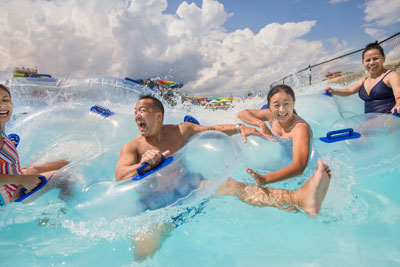
Modern-day aquatic parks are adding new programs in an effort to attract new guests and have them return multiple times, said Caron, and designing facilities that appeal to multiple demographics creates a destination that appeals to entire families, not just kids or swimmers only. “Parents now have a place to relax or get things done while their children have the time of their lives ripping down slides, wading in lazy rivers or catching an epic wave in the surf pool. Creating safe, inviting and easy-to-clean and maintain spaces results in high customer satisfaction and increased membership. It can also result in additional revenue streams as more facilities are capitalizing on rentals and point-of-sale interactivity.”
In designing aquatic parks, Bevard said the driver is offering exciting amenities and a positive experience, all while reducing the operational subsidy required. “The intent is to increase attendance through unique and enjoyable offerings that cater to a broad demographic and serve the community as a quality-of-life enhancement.” RM



